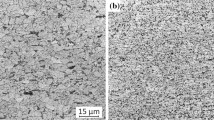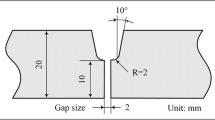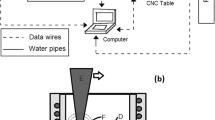Abstract
In this investigation, hybrid laser/arc welding (HLAW) was employed to join 8-mm-thick high-strength quenched and tempered steel (HSQTS) plates in the butt- and T-joint configurations. The influences of welding parameters, such as laser power, welding speed, stand-off distance (SD) between the arc of gas metal arc welding, and the laser heat source on the weld quality and mechanical properties of joints, were studied to obtain non-porous and crack-free fully-penetrated welds. The weld microstructure, cross-section, and mechanical properties were evaluated by an optical microscope, and microhardness and tensile tests. In addition, a finite element model was developed to investigate the thermal history and molten pool geometry of the HLAW process to join the HSQTS. The numerical study demonstrated that the SD had a paramount role in good synergy between the heat sources and the stability of the keyhole. For the butt-joint configuration, the results showed that, at a higher welding speed (35 mm/s) and optimum SD between the arc and laser, a fully-penetrated sound weld could be achieved. A non-porous weld in the T-joint configuration was obtained at a lower welding speed (10 mm/s). Microstructural evaluations indicated that the formation of residual austenite and the continuous network of martensitic structure along the grain boundary through the heat affected zone were the primary reasons of the softening behavior of this area. This was confirmed by the sharp hardness reduction and failure behavior of the tensile coupons in this area.













Similar content being viewed by others
References
Barenyi I, Hires O, Liptak P (2013) Changes in mechanical properties of armored UHSLA steel ARMOX 500 after over tempering. Probl Mechatron Armament Aviat Saf Eng 14:7–14
Magudeeswaran G (2008) Effect of welding consumables on tensile and impact properties of shielded metal arc welded high strength, quenched and tempered steel joints. J Iron Steel Res 15:87–94
Alkemade SJ (1996) The weld cracking susceptibility of high hardness armour steel. Australian defense science and technology organization: Aeronautical and Maritime Research Laboratory. file:///C:/Users/Mehdi/Downloads/10.1.1.555.2194(1).pdf
Magudeeswaran G, Balasubramaniarr V, Reddy GM et al (2008) Effect of welding processes and consumables on tensile and impact properties of high strength quenched and tempered steel joints. J Iron Steel Res 15(6):87–94
Katayama S, Abe Y, Mizutani M et al (2011) Deep penetration welding with high-power laser under vacuum. Trans JWRI 40(1):15–19
Zhang X, Ashida E, Tarasawa S et al (2011) Welding of thick stainless steel plates up to 50 mm with high brightness lasers. J Laser Appl 23(2):220–222
Mazar Atabaki M, Ma J, Yang G et al (2014) Hybrid laser/arc welding of advanced high strength steel in different butt-joint configurations. Mater Des 64:573–587
Mazar Atabaki M, Ma J, Liu W et al (2015) Pore formation and its mitigation during hybrid laser/arc welding of advanced high strength steel. Mater Des 67:509–521
Pan Q, Mizutani M, Kawahito Y et al (2016) High power disk laser-metal active gas arc hybrid welding of thick high tensile strength steel plates. J Laser Appl 28:120–124
Katayama S, Naito Y, Uchiumi S et al (2006) Physical phenomena and porosity prevention mechanism in laser-arc hybrid welding. Trans JWRI 35(1):13–18
Ming G, Zeng X, Hu Q (2007) Effects of gas shielding parameters on weld penetration of CO2 laser-TIG hybrid welding. J Mater Process Technol 184:177–183
Huang Y, Zhang YM (2010) Laser-enhanced GMA. Weld J 89:181–188
Mazar Atabaki M (2015) Study of issues in difficult-to-weld thick materials by hybrid laser arc welding. Dissertation, Southern Methodist University.
Zhou J, Tsai HL, Wang PC (2006) Transport phenomena and keyhole dynamics during pulsed laser welding. ASME J Heat Transf 128:680–690
Mazar Atabaki M, Nikodinovski M, Chenier P et al (2014) Experimental and numerical investigations of hybrid laser arc welding of aluminum alloys in the thick T-joint configuration. Opt Laser Technol 59:68–92
Norris JT, Perricone MJ, Roach RA et al (2007) Evaluation of weld porosity in laser beam seam welds: optimizing continuous wave and square wave modulated processes. SANDIA REPORT, U.S. Department of Energy, 1:1–27
Berger P, Hugel H, Graf T (2011) Understanding pore formation in laser beam welding. Phys Proced 12:241–247
Zhou J, Tsai HL (2008) Modeling of transport phenomena in hybrid laser-MIG keyhole welding. Int J Heat Mass Transf 51:4353–4366
Turichin G, Tsibulskiy I, Kuznetsov M et al (2015) Influence of the gap width on the geometry of the welded joint in hybrid laser-arc welding. Phys Proced 78:14–23
Hu Y, He X, Yu G et al (2012) Heat and mass transfer in laser dissimilar welding of stainless steel and nickel. Appl Surf Sci 258:5914–5922
Piekarska W, Kubiak M, Saternus Z (2010) Application of ABACUS to analysis of the temperature field in elements heated by moving heat sources. Achiev Foundry Eng 10(4):177–182
Liu W, Ma J, Mazar Atabaki M et al (2015) Joining of advanced high-strength steel to AA 6061 alloy by using Fe/Al structural transition joint. Mater Des 68:146–157
Campana G, Fortunato A, Ascari A et al (2007) The influence of arc transfer mode in hybrid laser-MIG welding. J Mater Process 191:111–113
Mazar Atabaki M, Yazdian N, Kovacevic R (2016) Partial penetration laser-based welding of aluminum alloy (AA 5083-H32). Optik Int J Light Electron Opt 127(16):6782–6804
Cao X, Wanjara P, Huang J et al (2011) Hybrid fiber laser-arc welding of thick section high strength low alloy steel. Mater Des 32:3399–3413
Nguyen TC, Weckman DC, Johnson DA et al (2006) High speed fusion weld bead defects. Sci Technol Weld Join 11:618–633
Bagger C, Flemmig O, Olsen O (2004) Review of laser hybrid welding. J Laser Appl 17(1):1–15
Frostevarg J, Kaplan AFH (2014) Undercuts in laser arc hybrid welding. Phys Proced 56:663–672
Mazar Atabaki M, Ma J, Liu W et al (2015) Hybrid laser/arc welding of advanced high strength steel to aluminum alloy by using structural transition insert. Mater Des 75:120–135
Kawahito Y, Mizutani M, Katayama S (2007) Elucidation of high-power fiber laser welding phenomena of stainless steel and effect of factors on weld geometry. J Phys D 40:5854–5859
Acknowledgements
The authors would like to thank Andrew Socha for his valuable help in the setup of the welding machines. This work was partially funded by NSF Grant IIP-1034652.
Author information
Authors and Affiliations
Corresponding author
Rights and permissions
About this article
Cite this article
Mazar Atabaki, M., Yazdian, N. & Kovacevic, R. Hybrid laser/arc welding of thick high-strength steel in different configurations. Adv. Manuf. 6, 176–188 (2018). https://doi.org/10.1007/s40436-017-0193-6
Received:
Accepted:
Published:
Issue Date:
DOI: https://doi.org/10.1007/s40436-017-0193-6




